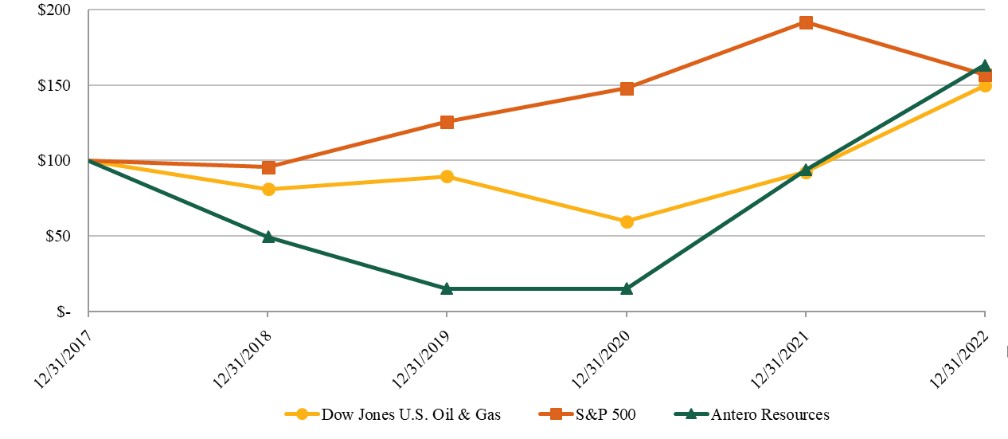Our producing properties are concentrated in the Appalachian Basin, making us vulnerable to risks associated with operating in one major geographic area.
Our producing properties are geographically concentrated in the Appalachian Basin in West Virginia and Ohio. As of December 31, 2022, all of our total estimated proved reserves were attributable to properties located in this area. As a result of this concentration, we may be disproportionately exposed to the impact of regional supply and demand factors, delays or interruptions of production from wells in this area caused by, and costs associated with, governmental regulation, state and local political activities, processing or transportation capacity constraints, market limitations, availability of equipment and personnel, water shortages or other drought related conditions or interruption of the processing or transportation of natural gas, NGLs or oil.
In addition, a number of areas within the Appalachian Basin have historically been subject to mining operations. For example, third-parties may engage in subsurface coal and other mining operations near or under our properties, which could cause subsidence or other damage to our properties, adversely impact our drilling operations or adversely impact third-party midstream activities on which we rely. In such event, our operations may be impaired or interrupted, and we may not be able to recover the costs incurred as a result of temporary shut-ins or the plugging and abandonment of any of our wells. Furthermore, the existence of mining operations near our properties could require coordination to avoid adverse impacts as a result of drilling and mining in close proximity. These restrictions on our operations, and any similar restrictions, could cause delays or interruptions or prevent us from executing our business strategy, which could materially adversely affect our results of operations and financial position.
Due to the concentrated nature of our portfolio of properties, a number of our properties could experience any of the same conditions at the same time, resulting in a relatively greater impact on our results of operations than they might have on other companies that have a more diversified portfolio of properties.
Negative public perception regarding us and/or our industry could have an adverse effect on our operations.
Opposition toward oil and natural gas drilling and development activities generally has been growing globally and is particularly pronounced in the U.S., and companies in our industry are often the target of activist efforts from both individuals and non-governmental organizations regarding safety, human rights, environmental matters, sustainability and business practices. Negative public perception regarding us and/or our industry may lead to increased litigation and regulatory, legislative and judicial scrutiny, which may, in turn, lead to new local, state and federal laws, regulations, guidelines and enforcement interpretations in safety, environmental, royalty and surface use areas. These actions may cause operational delays or restrictions, increased operating costs, additional regulatory burdens and increased risk of litigation. Moreover, governmental authorities exercise considerable discretion in the timing and scope of permit issuance and the public may engage in the permitting process, including through intervention in the courts. Negative public perception could cause the permits we need to conduct our operations to be withheld, delayed, challenged or burdened by requirements that restrict our ability to profitably conduct our business. In addition, anti-development activists are working to, among other things, reduce access to federal and state government lands and delay or cancel certain operations, such as drilling and development. If activism against oil and natural gas exploration and development persists or increases, there could be a material adverse effect on our business, financial condition and results of operations.
Customer Concentration and Credit Risk
The inability of our significant customers to meet their obligations to us may adversely affect our financial results.
Our principal exposures to credit risk are through receivables resulting from the sale of our natural gas, NGLs and oil production that we market to energy companies, end users, and refineries ($671 million as of December 31, 2022). We are also subject to credit risk due to concentration of receivables with several significant customers. The largest purchaser of our products during the year ended December 31, 2022 accounted for approximately 12% of our product revenues. We do not require all of our customers to post collateral. The inability or failure of our significant customers to meet their obligations to us or their insolvency or liquidation may adversely affect our financial results.
Our hedging transactions may become more costly or unavailable to us and expose us to counterparty credit risk.
Derivative arrangements could limit the benefit we would receive from increases in the prices for natural gas, NGLs and oil, which could also have an adverse effect on our financial condition. If natural gas, NGLs or oil prices upon settlement of our derivative contracts exceed the price at which we have hedged our commodities, we will be obligated to make cash payments to our hedge counterparties, which could, in certain circumstances, be significant.
In addition, U.S. regulators adopted a final rule in November 2019 implementing a new approach for calculating the exposure amount of derivative contracts under the applicable agencies’ regulatory capital rules, referred to as the standardized approach for counterparty credit risk (“SA-CCR”). As adopted, certain financial institutions are required to comply with the new SA-CCR rules
